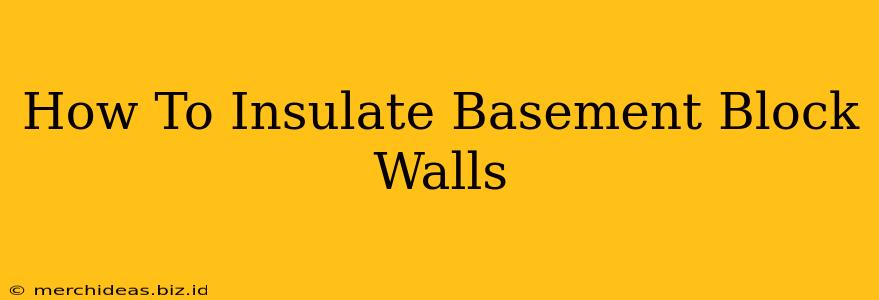A cold, damp basement can significantly impact your home's comfort and energy efficiency. Insulating your basement block walls is a crucial step towards creating a warmer, drier, and more comfortable living space. This comprehensive guide will walk you through the process, covering various insulation methods and helping you choose the best option for your needs.
Why Insulate Basement Block Walls?
Before diving into the how-to, let's understand the why. Insulating your basement block walls offers numerous benefits:
- Increased Energy Efficiency: Basement walls are notorious for heat loss. Proper insulation minimizes this loss, reducing your heating bills and lowering your carbon footprint.
- Improved Comfort: A well-insulated basement will feel significantly warmer and drier, making it a more pleasant space to live, work, or store items.
- Reduced Moisture: Insulation acts as a barrier against moisture penetration, preventing mold and mildew growth. This is particularly important in basements prone to dampness.
- Increased Home Value: Investing in basement insulation is a smart way to improve your home's overall value.
Choosing the Right Insulation Method for Basement Block Walls
Several insulation methods are suitable for basement block walls. The best choice depends on factors such as your budget, the condition of your walls, and your DIY skills.
1. Rigid Foam Insulation Boards (Extruded Polystyrene or XPS)
- Pros: Highly effective, easy to install, relatively inexpensive, good moisture resistance.
- Cons: Can be damaged by rodents if not properly protected.
- Installation: These boards are typically glued and mechanically fastened directly to the block walls. A vapor barrier is often recommended.
2. Spray Foam Insulation
- Pros: Excellent air sealing and insulation properties, conforms to uneven surfaces, fills cracks and crevices.
- Cons: More expensive than rigid foam, requires professional installation in many cases.
- Installation: A professional contractor sprays the foam onto the walls, creating a continuous insulating layer.
3. Fiberglass Batts or Rolls
- Pros: Relatively inexpensive, easy to install in some cases (furring strips may be needed).
- Cons: Less effective than rigid foam or spray foam, requires careful installation to avoid gaps and air infiltration, susceptible to moisture damage if not properly protected.
- Installation: These are typically installed between furring strips attached to the block walls. A vapor barrier is essential.
4. Insulated Concrete Forms (ICFs) – For New Construction
- Pros: Excellent insulation and structural strength.
- Cons: Only practical for new construction, more expensive than other methods.
- Installation: ICFs are used during the initial construction of the basement walls.
Step-by-Step Guide to Insulating Basement Block Walls (Using Rigid Foam as an Example)
This guide uses rigid foam as an example, but many steps are similar for other methods. Always consult manufacturer instructions for your specific insulation product.
- Prepare the Walls: Clean the walls thoroughly to remove any loose debris or dirt.
- Install a Vapor Barrier (Optional but Recommended): This prevents moisture from passing through the insulation and into the wall.
- Install Furring Strips (Optional): Furring strips create an air gap behind the insulation, improving its effectiveness. This is crucial for fiberglass insulation.
- Cut and Install the Rigid Foam Boards: Measure and cut the boards to fit your walls, ensuring a snug fit. Secure them to the wall using adhesive and mechanical fasteners.
- Finish the Walls: Once the insulation is installed, you can finish the walls with drywall, paneling, or other desired finishes.
Important Considerations
- Moisture Control: Addressing any existing moisture problems in your basement is crucial before insulating. Proper waterproofing and drainage are essential.
- Ventilation: Adequate ventilation is vital to prevent moisture buildup. Ensure your basement has proper ventilation to prevent future issues.
- Professional Installation: While some insulation methods can be DIY projects, for optimal results, especially with spray foam, consider hiring a professional contractor.
Insulating your basement block walls is a worthwhile investment that offers numerous benefits. By carefully considering the available methods and following the proper installation techniques, you can create a more comfortable, energy-efficient, and valuable home. Remember to always prioritize safety and follow local building codes.
